This week’s collection of books contains nonfiction and fiction intended to stimulate discussion in social studies lessons and promote thought-provoking independent reading. The books suggest multiple perspectives on familiar and not-so-familiar topics while showing the viability of using first-person narrative as material for social studies topics.
Ages 4–8
Emmanuel’s Dream: The True Story of Emmanuel Ofosu Yeboah. Laurie Ann Thompson. Ill. Sean Qualls. 2015. Schwartz & Wade/Random House.
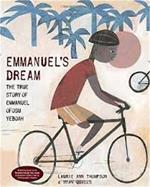 Emmanuel was born with a deformed leg but, with the support of his mother, he grew up doing things other Ghanaian children with disabilities did not do, including going to school (hopping two miles each way on one leg) and learning to ride a bicycle. At the age of 13, Emmanuel went to Accra to find work to support his family. Determined to show everyone that “being disabled does not mean being unable,” Emmanuel dreamed of cycling around Ghana. After training on a bike from the Challenged Athletes Foundation and canvasing door to door for support, Emmanuel made a 400-mile cycling journey across Ghana in just 10 days. The author’s note details Emmanuel Ofosu Yeboah’s work on behalf of the disabled since completing his first long-distance bike ride across Ghana in 2001.
Emmanuel was born with a deformed leg but, with the support of his mother, he grew up doing things other Ghanaian children with disabilities did not do, including going to school (hopping two miles each way on one leg) and learning to ride a bicycle. At the age of 13, Emmanuel went to Accra to find work to support his family. Determined to show everyone that “being disabled does not mean being unable,” Emmanuel dreamed of cycling around Ghana. After training on a bike from the Challenged Athletes Foundation and canvasing door to door for support, Emmanuel made a 400-mile cycling journey across Ghana in just 10 days. The author’s note details Emmanuel Ofosu Yeboah’s work on behalf of the disabled since completing his first long-distance bike ride across Ghana in 2001.
—CA
Gingerbread for Liberty! How a German Baker Helped Win the American Revolution. Mara Rockliff. Ill. Vincent X. Kirsch. 2015. Houghton Mifflin Harcourt.
 Responding to cries of “Revolution! Independence! Liberty!”, a German-born baker known throughout Philadelphia for his delicious gingerbread—“the best in all the 13 colonies”—joins General George Washington’s army and begins feeding the hungry Continental soldiers. Sent by Washington into enemy territory to persuade German troops hired by the British to defect to their side, he wins over the hungry soldiers not with words, but with the promise of “No empty bellies here. Not in my America.” Kirsch’s cut-paper illustrations feature the chubby baker and a lot of skinny soldiers as gingerbread cookie characters with white icing detailing. The author’s note provides information on Christopher Ludwick (1720–1801), the German baker who “helped win the American Revolution.” A simple gingerbread cookie recipe is on the endpapers.
Responding to cries of “Revolution! Independence! Liberty!”, a German-born baker known throughout Philadelphia for his delicious gingerbread—“the best in all the 13 colonies”—joins General George Washington’s army and begins feeding the hungry Continental soldiers. Sent by Washington into enemy territory to persuade German troops hired by the British to defect to their side, he wins over the hungry soldiers not with words, but with the promise of “No empty bellies here. Not in my America.” Kirsch’s cut-paper illustrations feature the chubby baker and a lot of skinny soldiers as gingerbread cookie characters with white icing detailing. The author’s note provides information on Christopher Ludwick (1720–1801), the German baker who “helped win the American Revolution.” A simple gingerbread cookie recipe is on the endpapers.
—CA
The Inventor’s Secret: What Thomas Edison Told Henry Ford. Suzanne Slade. Ill. Jennifer Black Reinhardt. 2015. Charlesbridge.
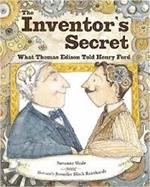 Young Thomas and Henry wanted to know how things worked. Their curiosity frequently led to experiments that got them into trouble. When they were older, they developed inventions that made life better for people. Henry’s interest in engines inspired him to invent a two-cylinder, four-stroke car. People laughed at Henry’s gas buggy, but they loved Thomas’s light bulb. Wondering what Edison’s secret was, Henry set out to meet Edison in New York City in 1896. In a conversation during a dinner where the famous inventor was the guest of honor, Edison revealed his secret to Ford, “Keep at it.” The illustrations, rendered in watercolor, ink, and black pencil, add detail and humor to the information about Ford’s development of a series of cars that he wanted to make affordable and suitable for families, from Model A to Model T (the Tin Lizzie). The back matter includes information on the friendship between the inventors, notes on Edison’s and Ford’s inventions featured in the story accompanied by archival photographs, source notes, a timeline of the lives of Edison and Ford, and a bibliography of websites and books.
Young Thomas and Henry wanted to know how things worked. Their curiosity frequently led to experiments that got them into trouble. When they were older, they developed inventions that made life better for people. Henry’s interest in engines inspired him to invent a two-cylinder, four-stroke car. People laughed at Henry’s gas buggy, but they loved Thomas’s light bulb. Wondering what Edison’s secret was, Henry set out to meet Edison in New York City in 1896. In a conversation during a dinner where the famous inventor was the guest of honor, Edison revealed his secret to Ford, “Keep at it.” The illustrations, rendered in watercolor, ink, and black pencil, add detail and humor to the information about Ford’s development of a series of cars that he wanted to make affordable and suitable for families, from Model A to Model T (the Tin Lizzie). The back matter includes information on the friendship between the inventors, notes on Edison’s and Ford’s inventions featured in the story accompanied by archival photographs, source notes, a timeline of the lives of Edison and Ford, and a bibliography of websites and books.
—SW
Ages 9–11
The Boy Who Fell Off the Mayflower or John Howland’s Good Fortune. P.J. Lynch. 2015. Candlewick.
 With a text based on historical facts set against dramatic double-spread paintings done in watercolor and gouache, Lynch tells the story of the Pilgrims’ voyage from England on the Mayflower and their first year in New Plymouth through the first-person narration of John Howland, an indentured servant of Pilgrim John Carver. Young John had the good fortune of surviving a fall from the deck of the ship in stormy waters. Lynch ends John’s story with a last-minute decision not to return to England on the Fortune the following year. In the author’s note, Lynch explains that this decision was fortunate for John because the Fortune was taken by French pirates on the voyage back to England. Lynch adds that this decision was also fortunate for the Plymouth Colony as John Howland became one of its foremost citizens.
With a text based on historical facts set against dramatic double-spread paintings done in watercolor and gouache, Lynch tells the story of the Pilgrims’ voyage from England on the Mayflower and their first year in New Plymouth through the first-person narration of John Howland, an indentured servant of Pilgrim John Carver. Young John had the good fortune of surviving a fall from the deck of the ship in stormy waters. Lynch ends John’s story with a last-minute decision not to return to England on the Fortune the following year. In the author’s note, Lynch explains that this decision was fortunate for John because the Fortune was taken by French pirates on the voyage back to England. Lynch adds that this decision was also fortunate for the Plymouth Colony as John Howland became one of its foremost citizens.
—CA
In the Footsteps of Crazy Horse. Joseph Marshall III. Ill. Jim Yellowhawk. 2015. Amulet/Abrams.
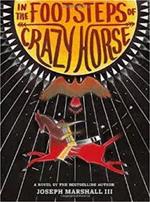 Jimmy McClean’s mother is Lakota and his father is half white. They live on the edge of the Rosebud Sioux Indian Reservation in southwest South Dakota, but that does not spare him the ridicule of students at his school because of his light brown hair. To help Jimmy understand his heritage, his grandfather Nyles High Eagle suggests a journey to visit the ancestral and historical sites where Crazy Horse, who also had light-colored hair as a young Lakota man, grew up and served his people. Their journey through three states to places that figured in American history includes stories of “the way it was” between 1852—when Crazy Horse was 13—and 1877, when he surrendered at Fort Robinson and died from a bayonet wound. A detailed map shows the journey Jimmy and Nyles took. In an author’s note, Marshall, a Sicangu Lakota (Rosebud Sioux), explains his purpose in in writing his book. Back matter includes a glossary and references.
Jimmy McClean’s mother is Lakota and his father is half white. They live on the edge of the Rosebud Sioux Indian Reservation in southwest South Dakota, but that does not spare him the ridicule of students at his school because of his light brown hair. To help Jimmy understand his heritage, his grandfather Nyles High Eagle suggests a journey to visit the ancestral and historical sites where Crazy Horse, who also had light-colored hair as a young Lakota man, grew up and served his people. Their journey through three states to places that figured in American history includes stories of “the way it was” between 1852—when Crazy Horse was 13—and 1877, when he surrendered at Fort Robinson and died from a bayonet wound. A detailed map shows the journey Jimmy and Nyles took. In an author’s note, Marshall, a Sicangu Lakota (Rosebud Sioux), explains his purpose in in writing his book. Back matter includes a glossary and references.
—SW
Two White Rabbits. Jairo Buitrago. Trans. Elisa Amado. Ill. Rafael Yockteng. Groundwood/House of Anansi.
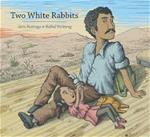 A man and his young daughter travel by foot through a desert environment and come to train tracks where many other people are waiting. The story, told from the daughter’s point of view, suggests adventure, but the father’s worried expression depicted in the illustrations suggests their lives are precarious as they travel on a train’s roof with many other adults and children. Having to escape soldiers who stop the train, the father finds work in a town while the child plays with a boy who gives her two rabbits. Once they resume their journey, this time in the bed of a truck, the father’s concern for the welfare of his child deepens. Upon reaching the border with its high fence, the father frees the rabbits. The father and child have yet to cross the border. The double-page illustrations, created digitally in muted, somber tones, show the hope and danger of their unfinished journey. A note at the end of the story provides information on the dangerous trips refugees take in attempting to make it across the border into the United States.
A man and his young daughter travel by foot through a desert environment and come to train tracks where many other people are waiting. The story, told from the daughter’s point of view, suggests adventure, but the father’s worried expression depicted in the illustrations suggests their lives are precarious as they travel on a train’s roof with many other adults and children. Having to escape soldiers who stop the train, the father finds work in a town while the child plays with a boy who gives her two rabbits. Once they resume their journey, this time in the bed of a truck, the father’s concern for the welfare of his child deepens. Upon reaching the border with its high fence, the father frees the rabbits. The father and child have yet to cross the border. The double-page illustrations, created digitally in muted, somber tones, show the hope and danger of their unfinished journey. A note at the end of the story provides information on the dangerous trips refugees take in attempting to make it across the border into the United States.
—SW
Ages 12–14
Rhythm Ride: A Road Trip Through the Motown Sound. Andrea Davis Pinkney. 2015. Roaring Brook/Macmillan.
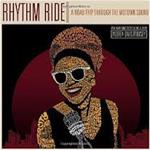 Pinkney offers a lively history of the Motown music label, narrated in a folksy tone by the Groove. Berry Gordy Jr., a member of an entrepreneurial Detroit family, achieved his dream of starting a recording company that would bring together talented black song writers, singers, and musicians with the establishment of Motown Records in 1959. A key to Gordy’s success was that he not only brought black artists into the Motown family and treated them fairly but also produced hits, songs that everyone wanted to hear. The reader of Rhythm Ride learns how the Motown sound changed the music world and influenced social and political history in the last half of the 20th century. Back matter includes an author’s note, a timeline, a selected discography, source notes, resources (books, magazines, and DVDs; websites; and theatrical productions), and an index.
Pinkney offers a lively history of the Motown music label, narrated in a folksy tone by the Groove. Berry Gordy Jr., a member of an entrepreneurial Detroit family, achieved his dream of starting a recording company that would bring together talented black song writers, singers, and musicians with the establishment of Motown Records in 1959. A key to Gordy’s success was that he not only brought black artists into the Motown family and treated them fairly but also produced hits, songs that everyone wanted to hear. The reader of Rhythm Ride learns how the Motown sound changed the music world and influenced social and political history in the last half of the 20th century. Back matter includes an author’s note, a timeline, a selected discography, source notes, resources (books, magazines, and DVDs; websites; and theatrical productions), and an index.
—CA
Taking Hold: From Migrant Childhood to Columbia University. Francisco Jiménez. 2015. Houghton Mifflin Harcourt.
 In this memoir, Jiménez sets out on a journey, leaving family, friends, sweetheart Laura, and teachers behind in California as he begins graduate studies at Columbia University in New York City. He connects the experience with the journey his family had taken 19 years earlier when he was 4-years-old and came across the Mexican border, not knowing what they would find when they entered the United States. Following his earlier books, The Circuit: Stories From the Life of a Migrant Child (1999), Breaking Through (2002), and Reaching Out (2009), Jiménez recounts the challenges of making his way in the culture of New York City and Columbia, supporting his family, and adjusting to the breakup with Laura. The memoir ends with his marrying Laura and her moving to New York to take a teaching position, the completion of his degrees, and his return to California as a professor at his undergrad alma mater, Santa Clara University.
In this memoir, Jiménez sets out on a journey, leaving family, friends, sweetheart Laura, and teachers behind in California as he begins graduate studies at Columbia University in New York City. He connects the experience with the journey his family had taken 19 years earlier when he was 4-years-old and came across the Mexican border, not knowing what they would find when they entered the United States. Following his earlier books, The Circuit: Stories From the Life of a Migrant Child (1999), Breaking Through (2002), and Reaching Out (2009), Jiménez recounts the challenges of making his way in the culture of New York City and Columbia, supporting his family, and adjusting to the breakup with Laura. The memoir ends with his marrying Laura and her moving to New York to take a teaching position, the completion of his degrees, and his return to California as a professor at his undergrad alma mater, Santa Clara University.
—SW
Ages 15+
My Seneca Village. Marilyn Nelson. 2015. Namelos.
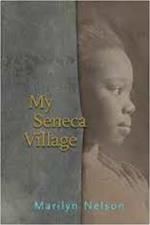 In a “Welcome to My Seneca Village” introduction, Nelson explains she made up the characters on the basis of their names and identifications in U.S. census records for Seneca Village, Manhattan’s first African American community of property owners on the upper west side of Manhattan Island. From 1825 to 1857, the village grew with schools, churches, gardens, and cemeteries and eventually incorporated Irish and German immigrants, until it was condemned to make way for Central Park, designed by Alfred Olmstead. Nelson begins each poem with an introduction to the characters, many of whom appear multiple times. Each poem, written in first person, recounts an event in the community. These personal stories of Nelson’s characters also chronicle historical events of the period such as economic recession, a cholera epidemic, the California Gold Rush, and the abolition movement. In an afterword, Nelson explains the structure of the poetry.
In a “Welcome to My Seneca Village” introduction, Nelson explains she made up the characters on the basis of their names and identifications in U.S. census records for Seneca Village, Manhattan’s first African American community of property owners on the upper west side of Manhattan Island. From 1825 to 1857, the village grew with schools, churches, gardens, and cemeteries and eventually incorporated Irish and German immigrants, until it was condemned to make way for Central Park, designed by Alfred Olmstead. Nelson begins each poem with an introduction to the characters, many of whom appear multiple times. Each poem, written in first person, recounts an event in the community. These personal stories of Nelson’s characters also chronicle historical events of the period such as economic recession, a cholera epidemic, the California Gold Rush, and the abolition movement. In an afterword, Nelson explains the structure of the poetry.
—SW
Symphony for the City of the Dead: Dmitri Shostakovich and the Siege of Leningrad. M.T. Anderson. 2015. Candlewick.
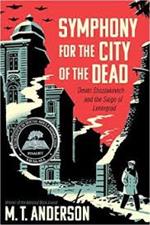 Anderson’s biography of the famous 20th-century composer is also a biography of 20th-century Russia. It begins with the Bolshevik Revolution and the early days of the Soviet government, when Shostakovich was a child in Leningrad. As a young composer and teacher, he composed music for the vibrant, hopeful, and experimental art world of music and theatre of 1920s Leningrad. Anderson details the era of Stalin in the 30s and his purges that decimated the art, military, and economic intelligentsia and the five-year plans that resulted in the deaths of millions of people in the countryside. The alliance between Hitler and Stalin fails in 1941 when Hitler’s military forces, believing the Russians were subhuman, attacked Russia and surrounded Leningrad in a strangle-hold siege that lasted almost 900 days. Anderson recounts the dramatic events that led to the first performance of Shostakovich’s Seventh Symphony, which became known as “The LeningradSymphony,” during the siege. Anderson includes extensive source notes to supplement the historical record discussed in the book.
Anderson’s biography of the famous 20th-century composer is also a biography of 20th-century Russia. It begins with the Bolshevik Revolution and the early days of the Soviet government, when Shostakovich was a child in Leningrad. As a young composer and teacher, he composed music for the vibrant, hopeful, and experimental art world of music and theatre of 1920s Leningrad. Anderson details the era of Stalin in the 30s and his purges that decimated the art, military, and economic intelligentsia and the five-year plans that resulted in the deaths of millions of people in the countryside. The alliance between Hitler and Stalin fails in 1941 when Hitler’s military forces, believing the Russians were subhuman, attacked Russia and surrounded Leningrad in a strangle-hold siege that lasted almost 900 days. Anderson recounts the dramatic events that led to the first performance of Shostakovich’s Seventh Symphony, which became known as “The LeningradSymphony,” during the siege. Anderson includes extensive source notes to supplement the historical record discussed in the book.
—SW
Sandip Wilson serves as associate professor in the College of Health and Education of Husson University in Bangor, ME. Carolyn Angus is former Director of the George G. Stone Center for Children's Books, Claremont Graduate University, CA.
These reviews are submitted by members of the International Reading Association's Children's Literature and Reading Special Interest Group (CL/R SIG) and are published weekly on Literacy Daily.